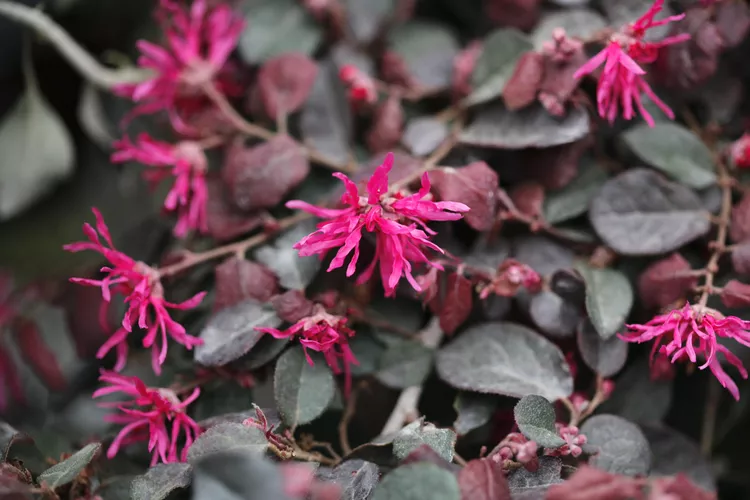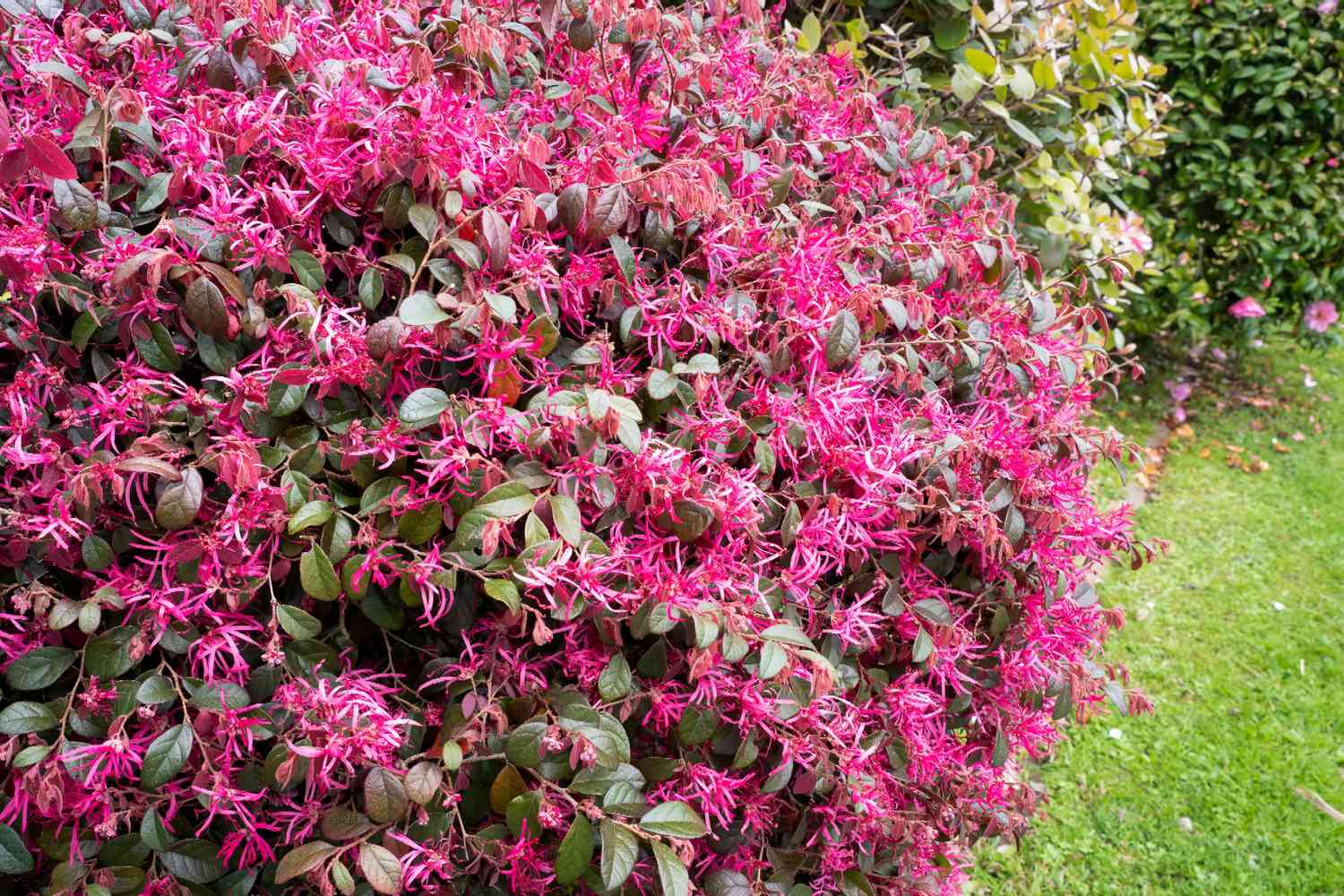
Loropetalum (Loropetalum chinense) is one of the first evergreen shrubs to burst forth with color after a long winter. Often called Chinese fringe flower, its delicate blossoms hang in lightly scented clusters ranging from white to pink to burgundy. Commonly used in the landscape as a specimen plant, along foundations, or pruned into a small tree, when can you expect your loropetalum to bloom?
The Blooming Season of Loropetalum
The appearance of loropetalum blooms depends on your hardiness zone, the plant cultivar, and the age of your shrub. You can expect the most blooms in mid-March through April (a bit later if you’re in zone 7a and lower). Mature shrubs that have not been severely pruned will often bloom in February. I have several compact ‘Carolina Moonlight’ TM loropetalums in a sunny, sheltered area that have bloomed during unseasonably warm early February days.
As new woody growth appears, expect a second, smaller bloom during the summer. The blooms should last around two to three weeks.
Factors Influencing Blooming
While the proverb may be “Bloom where you are planted”, loropetalums require specific conditions to put on the best show. If your fringe flowers are not performing well, follow these guidelines to resolve common blooming issues.
Sunlight
For the best flowering and leaf color (which can be nearly as dazzling as the blooms), the shrub needs full sun for at least six hours a day. A bit of partial shade in the afternoon is welcome when temperatures are sweltering. Chinese fringe flower prefers full sun with some afternoon partial shade for the best flowering and leaf color. They grow best in rich, moist, well-drained, acidic soils.
Soil Conditions
Loropetalum performs best in well-draining, nutrient-rich, acidic soil. In cooler climates, such as 6b to 7b, it is best to plant them in a protected area, away from winter winds. Organic mulch is always a plus to prevent the soil from drying out too quickly.
Pruning
While loropetalum can withstand severe pruning to tame an out-of-control shrub, timing is everything if you want lots of blooms. Flowers are produced on old wood so the best time to prune is right after the early spring blooms disappear. This gives the plant time to recover without the danger of a hard freeze or scorching temperatures and produce new summer growth that will flower the next spring.
Fall pruning is discouraged because you are cutting away the stems that produce flowers in the spring.
When you prune, remove any dead, diseased, or damaged branches. Step back and look at the shrub and remove any unruly shoots back to a bud or lateral branch that take away from the plant’s overall shape. Next, thin out crowded sections to improve light penetration and airflow to reduce diseases. Avoid the urge to give the shrub a crew cut. There are no square loropetalums in nature.
Care Tips for Healthy Blooming
While older, established loropetalums can withstand some drought, young shrubs need consistent watering to keep the soil moist. Mulching with organic material will help prevent the soil from drying out. However, overwatering in areas with heavy clay soils can result in root rot.
Before you plant a loropetalum, do a soil test because they do not tolerate alkaline soil (pH greater than 7.0) and leaves can become yellow. Amend the soil to adjust the pH level. Apply a light application of a balanced slow-release fertilizer in early April and again in mid-May.
Loropetalums have few serious pest problems and are considered deer resistant. They can be inflicted with a bacterial gall disease1 that causes branch dieback and reduces blooms. If you find a dark-colored gall, prune the branch several inches below the gall and dispose of the cuttings. Disinfect your pruning shears with rubbing alcohol between cuts to prevent bacterial spread.
Varieties of Loropetalum and Their Blooming Characteristics
You are sure to find a loropetalum variety that fits your garden space. As you make a selection, consider bloom and foliage colors for year-round interest.
Pink, Purple, and Red Flowering Varieties (Loropetalum chinense var. rubrum)
- ‘Blush’: Fuchsia pink blooms in early April. One of the first rubrum varieties, new leaf growth is a reddish-bronze and matures to an olive green. Form is compact and dense.
- ‘Burgundy’: Hot pink blooms in early spring. New leaf growth is reddish-purple and matures to purplish-green or dark olive with orange-red fall color.
- ‘Carolina Midnight’: Fuchsia pink blooms with deep purple foliage. This variety grows upright and can reach 10-12 feet tall and 8-12 feet wide.
- ‘Darkfire’: Hot pink blooms appear on dark purple foliage (remains dark purple year-round) and reaches 5 to 6 feet tall and wide.
- ‘Daruma’: Bright pink blooms contrast with plum-colored leaves on a compact 3-foot tall and wide shrub.
- Ever Red® ‘Chang Nian Hong’: True red blooms on dark burgundy foliage. Matures to a 5-foot height and width.
- Jazz Hands® Dwarf Pink ‘Kurenai’: Dark pink flowers on purple foliage with a cranberry undercurrent. Cultivar grows only 12 to 26 inches tall and three feet wide with a mounding habit.
- Pizazz®: Plum purple flowers on new reddish-purple foliage that becomes dark purple at maturity. Reaches 6 to 8 feet tall by 6 to 8 feet wide.
- ‘Purple Pixie’: Hot pink blooms on deep purple leaves with a height of 1 to 2 feet with a 4 to 5 feet spread.
- Red Diamond™ ‘Shang-Red: Vivid red flowers on dark burgundy foliage. Shrub reaches 6 feet tall and 6 feet wide.
- ‘Zhuzhou Fuchsia’: Deep pink blooms on blackish maroon foliage. Shrub reaches 10 to 20 feet tall and is the most cold hardy of the pink-flowering varieties.
White Flowering Varieties
All of these cultivars have white blooms but different growing habits and foliage colors.
- Carolina Moonlight™: Wider than it is tall, remains compact, a prolific bloomer from late winter to early spring.
- Emerald Snow® ‘Shang-White’: New foliage is lime green but darkens to rich green. Shrub grows about 4 feet tall and wide.
- Jazz Hands® Dwarf White ‘Hakuou’: Green foliage and a small cultivar growing 12 to 36 inches tall with a 36-inch spread.
- Snow Muffin® ‘Snowmound’: Blooms in late winter to early spring with light green foliage that darkens to dark olive green. Mature height is from 1 to 3 feet with a width of 2 to 3 feet.


